Review: 'Le Bois des Vierges', by Jean Dufaux and Béatrice Tillier
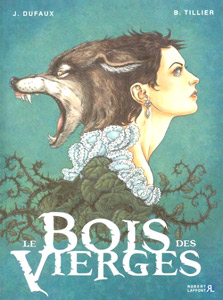 Le Bois des Vierges (The Virgins' Woods) is a French comic set in a medieval half-human, half-anthropomorphic world. It was released in three volumes between 2008 and 2013, written by Jean Dufaux and illustrated by Béatrice Tillier. Originally published by Robert Laffont (who then dropped their comics division), it was picked up by a second publisher, Delcourt, who re-released the first volume with a different cover. I reviewed the first book for Anthrozine.
Le Bois des Vierges (The Virgins' Woods) is a French comic set in a medieval half-human, half-anthropomorphic world. It was released in three volumes between 2008 and 2013, written by Jean Dufaux and illustrated by Béatrice Tillier. Originally published by Robert Laffont (who then dropped their comics division), it was picked up by a second publisher, Delcourt, who re-released the first volume with a different cover. I reviewed the first book for Anthrozine.
To be honest, this won't appeal to most North American furry fans, for several reasons. Not only is it in French, the wording is deliberately archaic, though not quite bordering on the Shakespearian. The human characters are the main focus, and the story isn't especially creative with the anthropomorphic ones. Oh, and good luck finding the set for under $75, not including shipping.
The main conflict in the story involves speciesism between four groups. The "tall beasts" (mainly wolves), the "short beasts" (including foxes), the humans, and the hybrids. The foxes and wolves are digitigrade and humanoid, but they consider themselves beasts. All the animal-people don't like humans very much, and the feeling is mutual. The tall beasts also hold the short beasts in contempt, and everyone hates the hybrids.
The story starts with an arranged marriage between two noble families, one human and one wolf, as part of a peace treaty. But Aube ("Dawn"), the human bride, wants nothing to do with her wolf husband, because she hates beasts, so she has him killed on their wedding night. This plunges the two kingdoms into war, and Aube escapes the carnage by taking refuge in a magical forest, the Virgins' Woods.
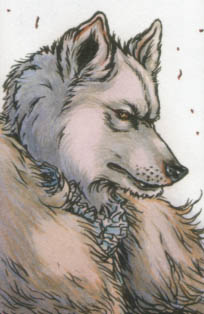 Flashing-forward, the devastating war has gone on for years. Neither army can hold out much longer, and each sends an envoy to find a military leader to inspire their troops and lead them to victory. Both potential new leaders are exiles. The humans want to be led by "Lord Clam" (seriously, that's his name) - a very Aryan-looking notorious wolf-killer. But he's been exiled because he's a hybrid, a werewolf. The beasts' choice is the brother of the wolf that Aube killed. Loup-Gris ("Gray Wolf") was exiled by his father for marrying a fox.
Flashing-forward, the devastating war has gone on for years. Neither army can hold out much longer, and each sends an envoy to find a military leader to inspire their troops and lead them to victory. Both potential new leaders are exiles. The humans want to be led by "Lord Clam" (seriously, that's his name) - a very Aryan-looking notorious wolf-killer. But he's been exiled because he's a hybrid, a werewolf. The beasts' choice is the brother of the wolf that Aube killed. Loup-Gris ("Gray Wolf") was exiled by his father for marrying a fox.
Wait a second - his dad exiled him for marrying a fox, but then turned around and married his other kid off to a human? Yep, major double-standard; he argues that the fox wasn't from a noble family. Anyway. Loup-Gris eventually agrees, while Lord Clam appears enigmatic and indecisive. However, his interest changes when he learns that the envoy who came to find him (Hugo), has a private letter from Aube's father to deliver to her.
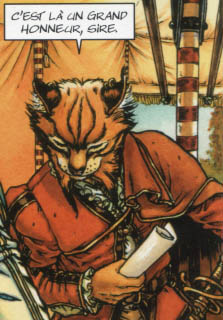 By an astonishingly convenient coincidence, years previously Lord Clam had saved Aube after a shipwreck, and she'd stayed at his castle briefly until she got freaked out by him and returned home. He's totally head-over-heels in love with her, and immediately wants to deliver the letter personally. This is fine with Hugo, because anyone who enters the forest who isn't a hybrid will get killed by its magic.
By an astonishingly convenient coincidence, years previously Lord Clam had saved Aube after a shipwreck, and she'd stayed at his castle briefly until she got freaked out by him and returned home. He's totally head-over-heels in love with her, and immediately wants to deliver the letter personally. This is fine with Hugo, because anyone who enters the forest who isn't a hybrid will get killed by its magic.
But wait - Aube isn't a hybrid! Well, the magic of the Virgins' Woods apparently includes young women like her under its definition of half-and-half things - virgins aren't quite girls any longer, but they aren't quite women yet. Yeah, this comic is not what I'd call progressive. (Each of the Delcourt front covers showcase Aube in a different pose, so I guess that's supposed to be the main selling point.) The other hybrids in the woods include centaurs, fauns (led by Pan), vicious harpies, mermaids (not seen), a family of anthro-pigs and a tree-creature (both killed off).
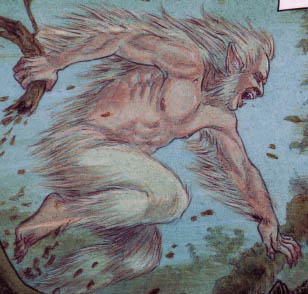 Pan is sick of the negative attitude towards hybrids. He wants to get rid of the virgins, have everyone else in the woods embrace their beast side, and join the war against humans. (I get the feeling he also wants power.) The centaurs prefer peace, but the fauns outnumber them. A shaky truce happens when Lord Clam shows up. The letter to Aube turns out to be her father forgiving her, except now she and Clam are trapped by the fauns. They're waiting to see how much of a beast Clam supposedly is, once the moon is full.
Pan is sick of the negative attitude towards hybrids. He wants to get rid of the virgins, have everyone else in the woods embrace their beast side, and join the war against humans. (I get the feeling he also wants power.) The centaurs prefer peace, but the fauns outnumber them. A shaky truce happens when Lord Clam shows up. The letter to Aube turns out to be her father forgiving her, except now she and Clam are trapped by the fauns. They're waiting to see how much of a beast Clam supposedly is, once the moon is full.
Clam turns into a werewolf and saves Aube's life a couple of times, so her hatred for beasts begins to soften. "Begins to soften"? I'm sorry, I meant "is tossed out the window, because she sleeps with him." And, although she's no longer a virgin, the forest doesn't kill her. Meanwhile, the political tensions within the woods have reached a breaking point. Pan makes his move, the whole place starts to burn down, and Lord Clam and Aube make their escape.
Meeting up with some of the remaining human nobility, there's still a remote chance they could end the war. Aube and Lord Clam get married (to demonstrate that humans and non-humans can get along), and then surrender themselves to the tall beasts, to apologize for Aube's errors and plead for the fighting to end. Like the fauns, they doubt Clam's beastliness, and he must have a fight to the death with an anthro-bear. During the fight he declares himself both human and beast, permanently taking on his hybrid form, and wins, proving that love conquers all. A new peace treaty is signed.
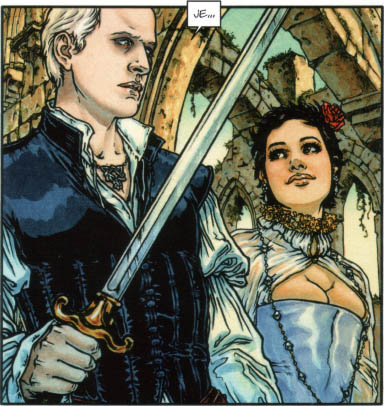 Overall the story is rather clichéd and has many plot holes. Aube's redemption is supposed to be one of the main story arcs. At worst, she feels lonely, scared and cut off from the world (due to her own actions), and she expresses regret about what happened. Otherwise, she never actually seems to suffer, never reaches a psychological point so low that it takes everything to be able to rise and become a better person. Nope, instead she throws her prejudices out the window with the ease of taking off a glove, has a night of passionate sex, and so the redemption begins. It never feels deserved. Almost everyone around her suffers or gets killed, and she comes through it all unscathed. I really didn't like her. Don't let thousands of needless deaths keep you up at night.
Overall the story is rather clichéd and has many plot holes. Aube's redemption is supposed to be one of the main story arcs. At worst, she feels lonely, scared and cut off from the world (due to her own actions), and she expresses regret about what happened. Otherwise, she never actually seems to suffer, never reaches a psychological point so low that it takes everything to be able to rise and become a better person. Nope, instead she throws her prejudices out the window with the ease of taking off a glove, has a night of passionate sex, and so the redemption begins. It never feels deserved. Almost everyone around her suffers or gets killed, and she comes through it all unscathed. I really didn't like her. Don't let thousands of needless deaths keep you up at night.
Lord Clam's story arc was more interesting, if lacking in detail. It turns out he's a notorious wolf-killer because he hates the beast inside himself. By killing a lot of wolves, he thought he might achieve inner peace, only it didn't work. His ongoing self-hatred manifests over and over during the story. So to see him finally admit to (and embrace) his true, full self during the final fight, it felt like a very real and heartfelt personal sacrifice and redemption at the same time. On the downside, there's an undead woman (who he created) back at his castle whom he treats very badly, he kills an innocent faun in a moment of bloodlust, and his werewolf form is still too human for my tastes. It has a kind of 1970s low-budget film look.
Furry-wise, we learn almost nothing about beast society. Aside from the occasional bestial rage, their culture appears essentially human. The medieval clothing and digitigrade stance means the artist only had to concern herself with heads and tails; their hands are simply long-nailed and colored differently. There's an interesting lynx character who at first appears mercenary, and gradually becomes a rare neutral party, able to talk to both sides. This makes sense, as the lynx bemoans its status – neither tall nor short enough to be fully accepted by either of the beast factions.
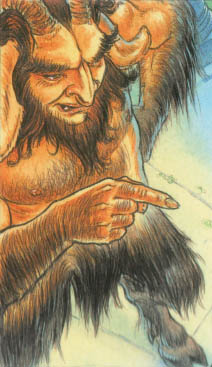 Aside from the foxes (who don't look much shorter than wolves), the short beasts don't show up at all – there's only a snippet of conversation about them and a few corpses, which implies there are also intelligent cats, roosters, donkeys, and other species. The author was obviously inspired by the Reynard Cycle, and accordingly the tall beasts consist of wolves and (later) a few bears... but no lions? Oh well.
Aside from the foxes (who don't look much shorter than wolves), the short beasts don't show up at all – there's only a snippet of conversation about them and a few corpses, which implies there are also intelligent cats, roosters, donkeys, and other species. The author was obviously inspired by the Reynard Cycle, and accordingly the tall beasts consist of wolves and (later) a few bears... but no lions? Oh well.
When volume 2 of this comic came out, I was initially interested in the hybrids because I partially got into furry fandom through Greek mythology. The artist's interpretation of centaurs is all right – weird noses though. Pan's design is rather ugly, with thick, floppy and fleshy ears. The harpies are downright frightening monsters. So I wouldn't recommend this comic for Greek mythology fans; besides, their appearances are few.
Otherwise, the artwork in this comic is top-notch. There's a recurring wolf's-head motif done in the style of Celtic knotwork that I liked a lot. It's just that for furries, the anthropomorphic characters are either secondary or suffer from design flaws. You'll also find a lot of gore sprinkled throughout the pages. Body parts get cut off, and you see the damage that swords and daggers do. Actually there's a funny bit of dialogue right at the end of the big fight. Lord Clam is standing in feral form, hands dripping in blood, holding a severed head:
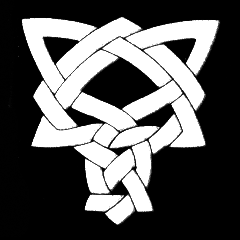
"If you still want me, Aube." – "I love you, wolf."
ISBNs/Purchasing
9782221107270 (v.1, Robert Laffont)
9782756019024 (v.1, Delcourt)
9782756019031 (v.2)
9782756025483 (v.3)
9782756042442 (3-volume set)
Generally though, due to the plot, difficult language, underused anthropomorphism, and high price, I can't recommend this for most North American furries. It's sad, because realistic-style furry content is rare in French comics; they usually go for cartoon-style, although there are occasional exceptions, like Blacksad. Still, I wanted to review this comic for the sake of showing the kinds of things that are out there. Now that it's finished, I'll be donating my copy to the What The Fur charity auction.
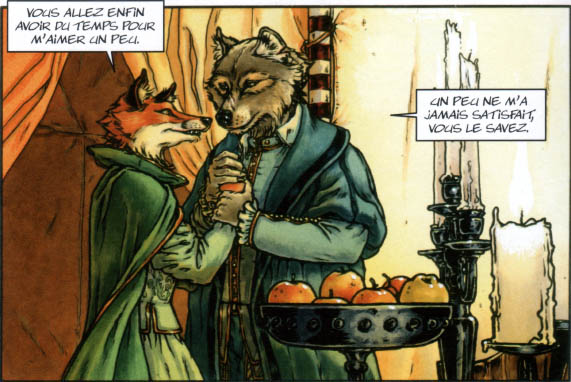
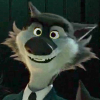
Comments
Post new comment